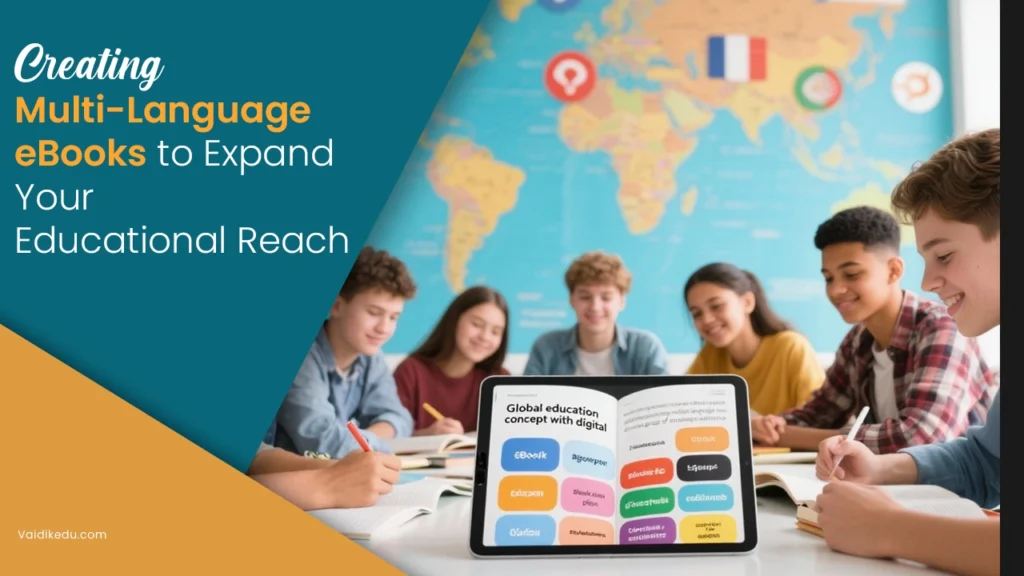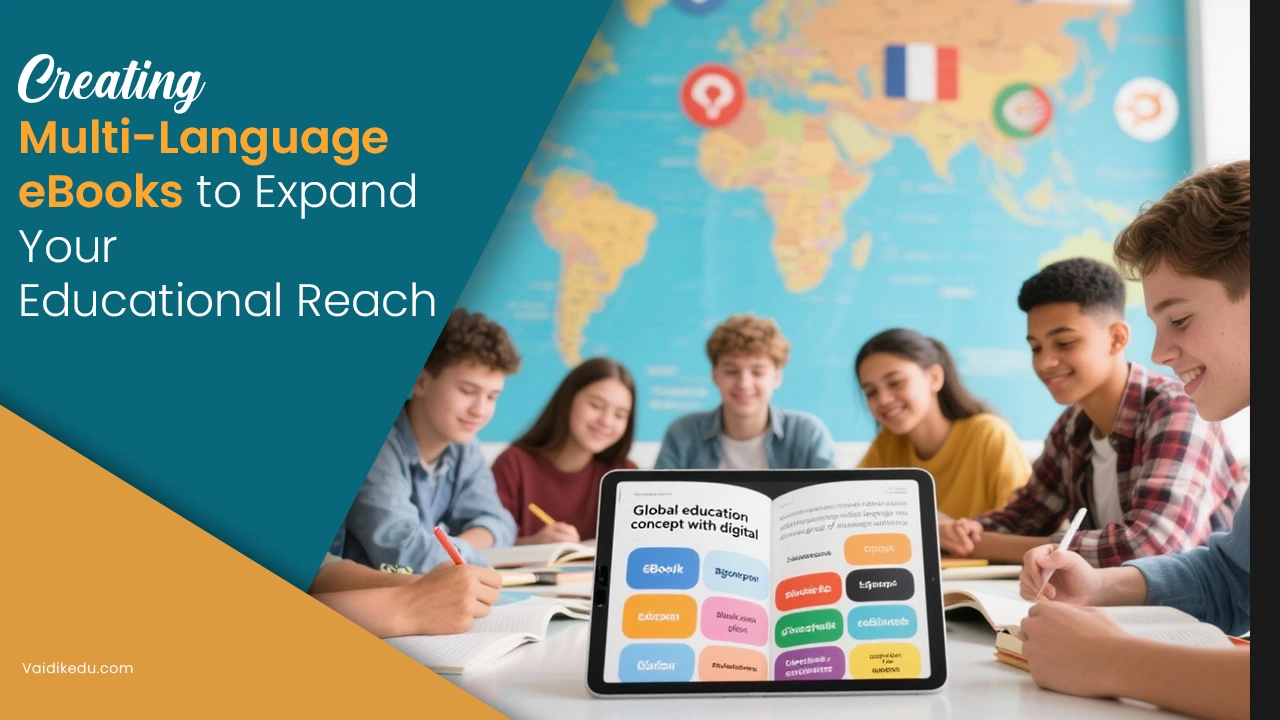Whether addressing global learners or different demographics of students in a single region, multi-language eBooks serve as an intermediary between cultures, breaking down barriers to language and promoting inclusiveness in education.
Being able to interact with and comprehend across languages has become an integral component of global education in an increasingly interconnected globe. The rise of digital learning tools and rising demand for multilingual education have made it imperative for educators and content creators to extend their thinking beyond monolingual materials.
In addition to promoting inclusivity, multilingual eBooks publishing Services provide a workable answer to the problems associated with linguistic diversity in the classroom. India, Canada, and Switzerland are examples of nations with diverse linguistic populations or several official languages that need educational resources that take this variety into account.
Similarly, educational resources in their native languages are beneficial to global learners who access content from around the globe. By guaranteeing that no student is left behind only because of language challenges, this inclusivity increases the effect and equity of education.
Additionally, having eBooks available in different languages improves understanding and retention by allowing students to understand complicated concepts in the language they are most comfortable with.
This blog discusses the significance of multi-language eBooks, the difficulties in producing them, and the solutions that can assist educators and publishers in overcoming these obstacles to increase their educational reach.
From a business standpoint, producing multi-language eBooks is capable of opening up fresh markets for educational publishers and institutions. By localizing content to cater to different regions and languages, publishers can address a wider audience, increasing their impact and revenue. Development of multi-language eBooks requires innovative technologies, effective localization strategies, and thoughtful instructional design Development.
The Requirement for E- Books in Multiple Languages
Because of the variety of learners in today’s globalized society, multilingual eBooks are necessary. Because they are better able to connect with the content, many children do better academically when they learn in their mother tongue.
According to research, when material is delivered in a language that they are most familiar with, pupils are more likely to understand and remember it. By offering educational resources in a learner’s preferred language, multilingual eBooks meet this requirement and make learning more approachable and significant.
It is not only advantageous but also necessary to provide content in several languages in areas with multilingual educational systems. For example, multi-language eBooks guarantee that students from various linguistic origins have equitable access to high-quality education in nations like India, where pupils frequently learn in regional languages, English, or a combination of both.
Additionally, multilingual eBooks offer freedom in learning in their preferred language without the need for in-person translations, making them an invaluable resource for international learners looking for self-paced learning materials.
Furthermore, the significance of multilingual content has been underlined by the quick growth of digital learning platforms and online education.
Multilingual eBooks are becoming an essential tool to guarantee worldwide access as educational institutions and eLearning providers look to accommodate international students.
Having eBooks available in many languages, whether for STEM topics, the humanities, or vocational training, promotes inclusivity in education and allows organizations to engage with a diverse global student body.
The Difficulties of Producing Multilingual E- Books
Creating eBooks in multiple languages is not without its difficulties. Localization, which extends beyond translation, is one of the main obstacles. Content must be localized to take into account the linguistic, social, and cultural quirks of a particular audience.
Idioms, metaphors, and culturally unique examples, for example, might not be relatable to every student. In order to ensure that the content is accurate, relatable, and interesting for learners in various places, effective localization necessitates extensive research and expert input.
Keeping things consistent across languages presents another difficulty. Making sure that the original material’s meaning and intent are preserved is essential when translating information.
Content that is poorly translated or misunderstood may cause confusion and lessen the eBook’s usefulness. Furthermore, careful preparation and coordination are needed to ensure a consistent tone, style, and instructional design across several languages.
There are additional difficulties in integrating technology when creating eBooks in multiple languages. Although AI-powered localization platforms and translation software might expedite the process, they might not always be able to grasp the subtleties of human language.
Therefore, producing high-quality multilingual content requires a combination of human experience and technology. Lastly, creating multilingual eBooks can be expensive and time-consuming, particularly for smaller businesses with less resources.
Methods For Producing E- Books in Multiple Languages
Despite these obstacles, there are a number of techniques and resources that can make the process of producing multilingual eBooks more efficient. The first step in effective localization is careful preparation.
Crucial steps in the process include determining the target audience, comprehending their linguistic and cultural preferences, and establishing specific learning objectives. Working together with educators and native language specialists guarantees that the information is correct, relevant to the culture, and interesting.
Utilizing technology is yet another effective remedy. Time and money can be saved by automating portions of the translation process with AI-powered tools and translation software like Google Translate, DeepL, and specialist eLearning localization systems.
These days, a lot of these programs have features like machine learning algorithms that increase accuracy and context-aware translation. To guarantee quality and resolve any discrepancies, human control is necessary.
Creating content with adaptability in mind also facilitates multilingual eBook adaptation. For example, translation and localization can be made easier by removing culturally specific references and utilizing plain, uncomplicated language.
Additionally, multimedia components such as images, films, and infographics should be thoughtfully created to accommodate various cultural contexts. Multilingual eBooks can be made even more accessible with interactive elements like clickable translations or text-to-speech.
The flexibility required to produce multilingual material effectively is offered by cloud-based writing tools and platforms that facilitate multi-language publishing, such as Adobe InDesign, Canva, and eBook maker applications. With the use of these technologies, instructional designers can control translations, modify layouts, and preserve consistency among eBooks in various languages.
Advantages of E- Books in Multiple Languages
There are several advantages for publishers, educators, and students when multilingual eBooks are created. These eBooks give students the chance to access excellent instructional resources in their mother tongue, increasing the effectiveness and inclusivity of learning.
Multilingual eBooks give teachers the opportunity to connect with a wide range of people, overcoming linguistic divides and promoting intercultural understanding.
By meeting the demands of international learners, multi-language eBooks give publishers and organizations access to new markets and sources of income.
By showcasing a dedication to accessibility and inclusion, they also improve brand reputation. Additionally, corporations can support global education goals like lowering inequality and encouraging opportunities for lifelong learning for everyone by providing information in different languages.
Conclusion
eBooks in several languages are a game-changer for contemporary education, allowing institutions to reach a wider audience and making education more widely available.
Teachers and publishers may overcome the difficulties of localization to provide interesting, superior multilingual content by addressing language variety and utilizing technology. Multilingual eBooks are not just a choice but also a need in an era where education is becoming more digital and globalized in order to promote equity, inclusivity, and successful learning outcomes.
Frequently Asked Questions
Multi-language eBooks are electronic books created to offer instructional materials in several languages, meeting the needs of a wide range of learners from different linguistic and cultural backgrounds.
By addressing linguistic variety, providing native-language access to content, and enhancing comprehension and retention, they increase educational inclusivity.
Effective localization, preserving linguistic integrity, incorporating translation technology, and controlling production costs and time are among the difficulties.
The process of producing multilingual material can be streamlined via localization platforms, cloud-based authoring platforms like Adobe InDesign, and AI-powered translation tools.
They help publishers access a wider audience, build their brand, and meet the increasing need for multilingual educational materials around the world.









